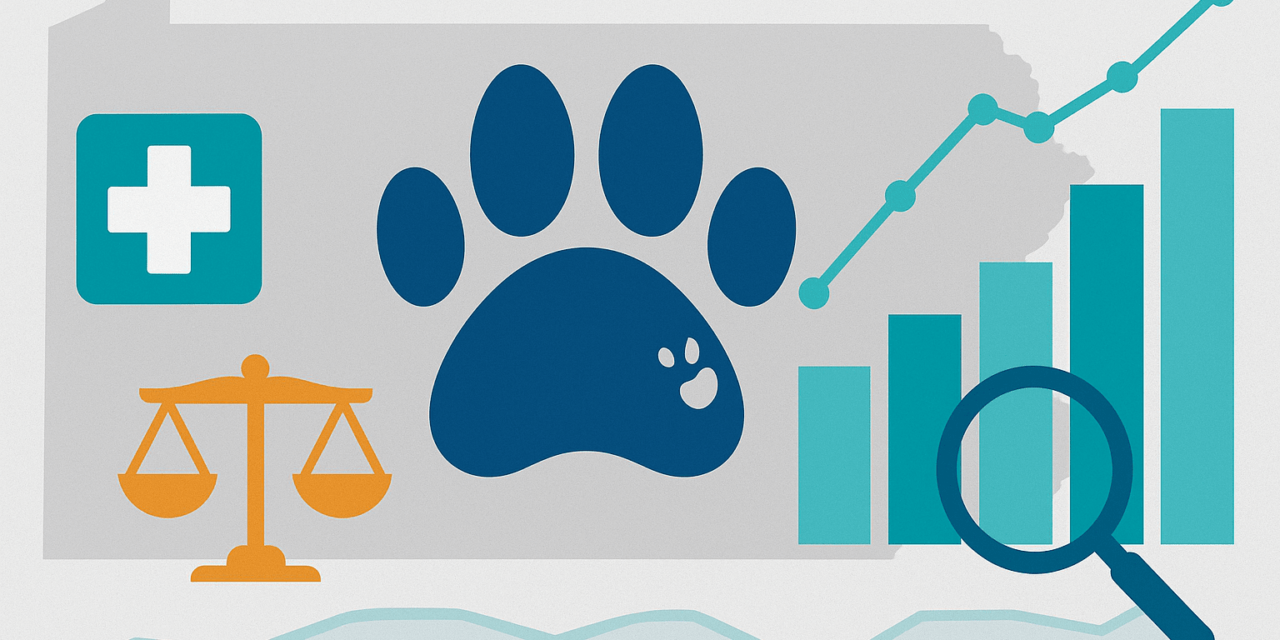Dog bites aren’t just a neighborhood nuisance they’re a growing public-health and financial trend that affects emergency departments, insurers, pet owners, and legal practices. In Pennsylvania the signals are clear: increasing reports at the county level, steady emergency-department burden, and rising insurance claim costs nationally that ripple into the state market. This article walks through the trends, what’s driving them, how the exposure translates into claims, where Pennsylvania stands, and practical steps for law firms, clinicians, insurers, and local governments.
Dog-bite liability claims and average payout sizes have climbed in recent years, driven by more pets, higher medical costs, and shifting social patterns. In Pennsylvania, county health departments and hospital discharge datasets show meaningful volumes of reported animal bites and bite-related hospital visits. The result: more emergency care, larger settlements, and a growing area of demand for legal services that specialize in bite injuries and liability.
Why dog-bite injuries matter beyond the bite itself
A dog bite can range from a minor puncture to a devastating injury. Severe wounds often require emergency care, specialty surgery, and extended follow-up, and pediatric cases can be especially costly. Beyond medical bills, bitten victims face lost wages, scarring, infection risk, and emotional trauma — factors that fuel higher claim values when cases proceed to settlement or suit.
National forces pushing counts and costs upward
Several national dynamics help explain the rise in claims and severity:
-
More households adopted dogs during the pandemic, increasing the number of dog-human interactions.
-
Medical inflation and more aggressive damage awards have lifted average payouts.
-
Changing usage patterns — more outdoor activities, denser urban living, and increases in micromobility and shared spaces — create more contact points between dogs and strangers.
-
Better reporting and surveillance by public health entities mean more bites get logged, making trends more visible.
These forces combine to increase both the frequency of reported bites and the monetary exposure when claims are filed.
What Pennsylvania data is showing
Pennsylvania’s landscape is mixed but instructive. County animal-control or public-health reports in large metro areas document thousands of reported bites each year, the majority involving dogs. Hospital discharge data and emergency-department records confirm that dog bites continue to be a common reason for pediatric ED visits and a nontrivial cause of hospital admissions.
County reports are an immediate barometer of local exposure: they track where bites happen, whether vaccines were involved, and often whether the dog was known to the victim. Hospital datasets reveal the clinical burden and costs: how many bites produced surgical interventions, how many required inpatient stays, and which hospitals see the most bite-related admissions.
Digging into the drivers in Pennsylvania
Several local factors matter:
-
Urban density and park use: High pedestrian density and crowded dog-friendly spaces increase interactions.
-
“Pandemic dogs” and socialization gaps: Dogs acquired during lockdowns sometimes missed critical socialization windows, which can increase reactive behavior in novel situations.
-
Demographic hotspots: Pediatric bites remain a major concern; children are overrepresented among bite victims due to behavior and size.
-
Reporting differences by county: Some counties capture more bites due to robust public-health outreach, which can look like an increase even if incidence is stable.
The insurance and legal market response
Insurers are reacting to rising frequency and severity. Underwriting changes, higher premiums, and stricter exclusions are increasingly common. For plaintiffs and defendant counsel, that means:
-
More high-value claims arriving at law firms that specialize in premises and animal-liability work.
-
Stronger insurer defense postures for certain breeds or for incidents involving homeowners and renters policies.
-
Opportunities for plaintiff counsel when medical severity and documentation support larger damages.
For law firms, the shifting market also creates tactical needs: earlier preservation of evidence (photos, vet records, witness statements), structured demand packages for carriers, and smart mediation strategies that stress medical severity rather than just nominal fault.
Clinical and hospital implications
Emergency departments and surgical centers continue to see bite injuries across age groups. Pediatric units remain busy with facial injuries and lacerations that require repair and, in some cases, plastic surgery. Clinicians and hospital administrators should:
-
Track seasonal trends and local spikes to staff appropriately.
-
Coordinate with public health for bite reporting and follow-up.
-
Educate patients on wound care and infection prevention to reduce complications that increase cost and legal exposure.
Where the data gaps are and why that matters
Pennsylvania has useful county reports and hospital discharge data, but there is no single statewide, public catalog that neatly tallies paid dog-bite claims by county and year. Insurance company data often remains proprietary. That fragmentation creates two realities:
-
Public-health and hospital datasets give strong signals about medical burden and ED strain.
-
Claim and payout picture requires aggregation from insurer reports, court records, and specialized data sources to fully measure financial exposure.
Bridging these gaps requires targeted data requests to hospital data councils, aggregation of county bite reports, and outreach to insurer bulletins that publish trends.
Practical recommendations for stakeholders
For law firms
-
Build a rapid intake checklist for bite incidents: preserve photos, obtain the dog owner’s information, secure witness contact details, and collect medical records immediately.
-
Cultivate relationships with pediatric and plastic surgery experts for prompt evaluation and credible testimony.
-
Track local county bite reports and PHC4 hospital trends to identify geographic markets with rising case volumes.
For clinicians and hospitals
-
Standardize wound photography and charting practices to support both clinical care and possible future legal needs.
-
Coordinate with public health reporting to ensure accurate surveillance and follow-up vaccination management.
-
Consider community outreach on dog safety and bite prevention to reduce ED volume.
For insurers and carriers
-
Reassess underwriting and coverage language for dog-bite exposure, and consider education programs for insureds to reduce risk.
-
Work with local public-health partners to identify repeat problem properties or repeat offenders.
For local government and animal control
-
Improve public education on dog socialization, leashing rules, and bite reporting.
-
Target high-incident neighborhoods for outreach and enforcement to prevent future bites.
Opportunities for targeted action and marketing
For law firms and practices, rising bite counts and larger claim payouts mean client acquisition opportunities. High-quality content that explains how to handle bites, what medical documentation matters, and how liability is determined can position a firm as the go-to resource. Geo-targeted campaigns in counties with rising bite volumes are likely to outperform general outreach.
Case handling checklist (practical intake & litigation tips)
-
Secure immediate medical records and retain photographs of wounds.
-
Get animal-owner info (vaccination, prior behavior), licensing records, and municipal bite reports.
-
Preserve witness statements within 48–72 hours.
-
If severe injury: request surgical and specialist notes, and estimate future care needs early.
-
Consider expert retention early: reconstructors, veterinary behaviorists, pediatric surgeons, and life-care planners if injuries are catastrophic.
What to watch over the next 12–24 months
-
Continued insurer adjustments in liability coverage that affect settlement dynamics.
-
Any shifts in public-health reporting standards that might make county trends more consistent statewide.
-
The potential for targeted prevention programs in high-incident locales to reduce ED volume and claims.
Dog bites are more than isolated incidents — they are a confluence of pet ownership trends, public spaces, medical costs, and insurance responses. In Pennsylvania, rising reports and hospital burden create a practical playbook for clinicians, lawyers, insurers, and municipal leaders. Those who monitor the right local datasets, standardize intake and documentation, and invest in prevention and education will be best positioned to reduce harm and manage exposure.





